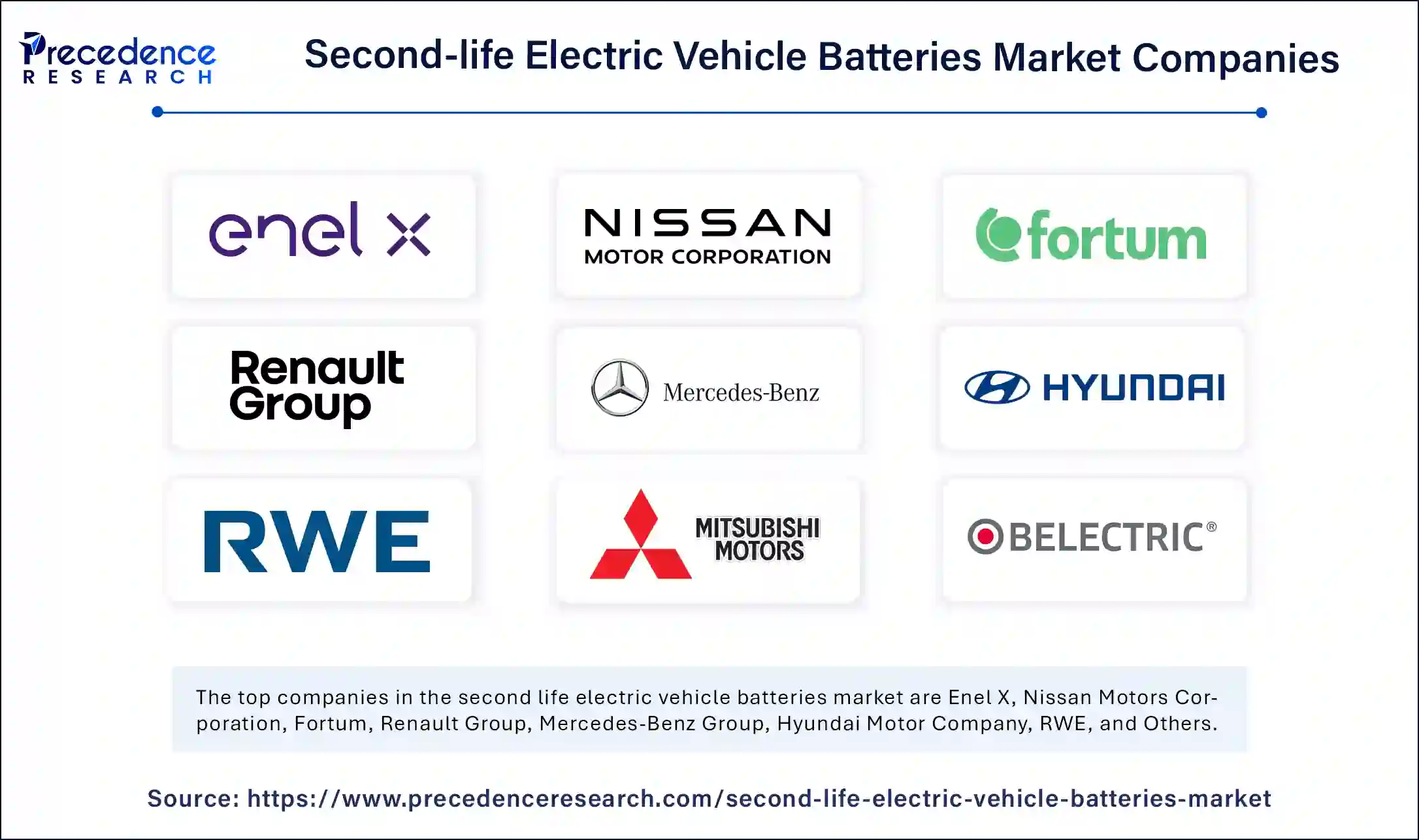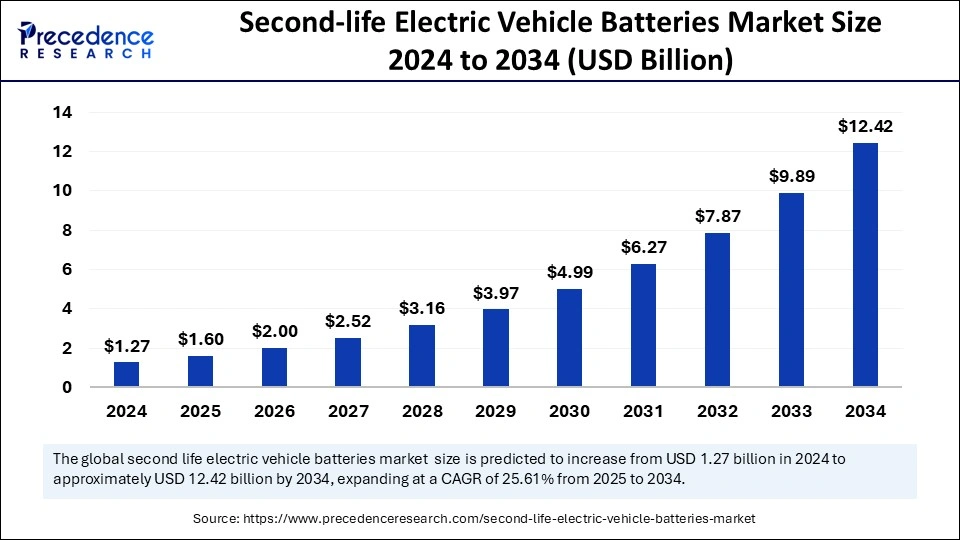The global second-life electric vehicle batteries market size is accounted to reach around USD 12.42 billion by 2034, increasing from USD 1.27 billion in 2024, with a CAGR of 25.61%.
Get a Free Sample Copy of the Report@ https://www.precedenceresearch.com/sample/5793
Second-life Electric Vehicle Batteries Market Key Points
-
Asia Pacific led the second-life EV batteries market, securing the highest market share in 2024.
-
Europe is set to register the fastest growth from 2025 to 2034.
-
Lithium-ion batteries held the top spot by battery type in 2024.
-
The lead-acid battery segment is expected to expand significantly during the forecast timeline.
-
Power backup emerged as the leading application segment in 2024.
-
EV charging applications are anticipated to grow swiftly over the next decade.
-
The commercial end-use segment dominated the market in 2024.
-
Residential use is projected to be the fastest-growing segment from 2025 to 2034.
Role of AI in the Second-life Electric Vehicle Batteries Market
Artificial Intelligence (AI) is playing a pivotal role in advancing the second-life electric vehicle (EV) batteries market by enhancing battery assessment, optimizing reuse potential, and improving lifecycle management. One of the most critical applications of AI in this space is its ability to analyze the state of health (SoH) and performance data of used EV batteries. Using machine learning algorithms and predictive analytics, AI can accurately evaluate which batteries are suitable for secondary applications, such as energy storage systems or backup power.
AI also streamlines the sorting and classification process of decommissioned EV batteries, making recycling and repurposing more efficient. By predicting remaining battery life and potential failure points, AI helps maximize battery utilization while reducing risks associated with degraded cells.
Furthermore, AI is enabling smart energy management in second-life battery systems. It optimizes charging/discharging cycles, ensures balanced energy distribution, and reduces energy loss. This makes second-life batteries more reliable for use in applications like renewable energy integration, EV charging infrastructure, and residential or commercial backup systems.
In the manufacturing and R&D space, AI supports design improvements and process automation, helping manufacturers better understand usage patterns and feedback from second-life battery systems in the field. As a result, AI is crucial for driving sustainability, efficiency, and cost-effectiveness in the circular economy of electric vehicle batteries.
Second-life Electric Vehicle Batteries Market Growth Factors
-
Rising Demand for Energy Storage Solutions
As the world shifts toward renewable energy sources like solar and wind, there’s an increasing need for efficient, cost-effective energy storage systems. Second-life EV batteries serve as an ideal solution due to their availability and remaining energy capacity, fueling market growth. -
Surge in Electric Vehicle Adoption
With global EV sales on the rise, a growing number of batteries are reaching the end of their automotive life. These batteries, though no longer viable for EV use, retain significant storage potential, creating a steady supply for the second-life market. -
Environmental and Sustainability Goals
Governments and industries are prioritizing circular economy strategies and sustainable practices. Reusing EV batteries helps reduce electronic waste and carbon emissions, aligning with global environmental targets and driving adoption in the second-life market. -
Cost-effectiveness Compared to New Batteries
Second-life batteries are substantially cheaper than new energy storage units, making them a compelling option for budget-conscious consumers and businesses, especially in developing markets and rural electrification projects. -
Government Incentives and Regulations
Supportive policies, tax credits, and recycling mandates from governments worldwide are encouraging battery reuse and promoting the development of second-life battery infrastructure. -
Advancements in Battery Diagnostics and AI Integration
Technologies like AI and IoT are making it easier to evaluate and manage used batteries, ensuring safety, efficiency, and performance. These innovations are increasing confidence in second-life battery applications. -
Growing Need for Backup Power and Off-grid Solutions
Demand for reliable, low-cost power backup in commercial, industrial, and residential sectors—especially in regions with inconsistent electricity—boosts the use of second-life batteries in stationary storage systems.
Market Scope
| Report Coverage | Details |
| Market Size by 2034 | USD 12.42 Billion |
| Market Size in 2025 | USD 1.60 Billion |
| Market Size in 2024 | USD 1.27 Billion |
| Market Growth Rate from 2025 to 2034 | CAGR of 25.61% |
| Dominating Region | Asia Pacific |
| Fastest Growing Region | Europe |
| Base Year | 2024 |
| Forecast Period | 2025 to 2034 |
| Segments Covered | Battery Type, Application, End-use, and Regions. |
| Regions Covered | North America, Europe, Asia-Pacific, Latin America, and the Middle East & Africa. |
Market Dynamics
Market Drivers
One of the primary drivers of this market is the exponential growth in electric vehicle sales, leading to a rising volume of used batteries suitable for secondary use. Additionally, the demand for cost-effective energy storage solutions is growing rapidly, especially in renewable energy systems and off-grid applications. Governments and regulatory bodies are also encouraging sustainable practices through supportive policies and incentives, further fueling market expansion. Technological progress in battery diagnostics, monitoring, and AI-based performance optimization has significantly improved the viability and safety of using second-life batteries.
Market Opportunities
The second-life EV battery market presents numerous growth opportunities, especially in developing economies, where energy storage solutions are needed for grid stability, rural electrification, and backup power. The integration of second-life batteries in smart grids and renewable energy systems offers a cost-effective solution for managing energy intermittency. Additionally, the growing adoption of electric mobility in commercial fleets and the need for affordable infrastructure can benefit significantly from second-life battery installations. Innovations in battery management systems (BMS) and AI are enabling better prediction of battery life and performance, enhancing user trust and expanding market potential.
Market Challenges
Despite its promise, the market faces several challenges. The lack of standardized testing and certification processes for second-life batteries poses a safety risk and creates uncertainty for users and suppliers. Variability in battery conditions, depending on their usage history, makes it difficult to establish consistent performance metrics. Moreover, regulatory ambiguities in certain regions can hinder the trade and reuse of these batteries. Logistics and recycling infrastructure also need to be scaled up to support the collection, assessment, and repurposing of used EV batteries on a global scale.
Regional Insights
-
Asia Pacific currently dominates the second-life EV battery market, thanks to its large EV manufacturing base and supportive government initiatives, particularly in China and India. China leads in terms of both EV adoption and battery reuse programs, making it a global hub for second-life battery solutions.
-
Europe is projected to witness the fastest growth during the forecast period, driven by stringent environmental regulations, a focus on green energy, and significant investments in circular economy projects. Countries like Germany, France, and the Netherlands are promoting battery reuse to support their decarbonization goals.
-
North America is also a significant player, with the U.S. investing heavily in clean energy infrastructure and EV expansion. However, regulatory clarity and infrastructure development are needed to unlock the full potential of second-life batteries in the region.
-
Other emerging markets in Latin America and Africa offer untapped potential for second-life applications, particularly for rural electrification and low-cost energy storage needs.
Second-life Electric Vehicle Batteries Market Companies

- Enel X
- Nissan Motors Corporation
- Fortum
- Renault Group
- Mercedes-Benz Group
- Hyundai Motor Company
- RWE
- Mitsubishi Motors Corporation
- BELECTRIC
- BeePlanet Factory SL
- B2U Storage Solutions, Inc.
- RePurpose Energy Inc.
- ReJoule
- Cactos Oy
- ECO STOR AS
- Connected Energy Ltd.
- Smartville Inc.
- Lohum Cleantech Private Limited
- DB Bahnbau Gruppe GmbH
Leader’s Announcements
- In June 2023, MG Motor India, a British automotive brand with a legacy spanning 99 years, joined forces with LOHUM, the largest producer of sustainable energy transition material in India, to create a comprehensive system for the reuse and lifecycle management of electric vehicle batteries.
Recent Developments in Second-Life Electric Vehicle Batteries Market
- In October 2024, Vision Mechatronics and JSW MG Motor entered into a collaboration and launched the India’s first high-voltage (HV) second-life battery with an indigenous active balancing battery management system.
- In February 2023, B2U Storage Solutions, Inc., a prominent provider of large-scale energy storage systems that utilize second-life electric vehicle batteries, revealed that its SEPV Sierra hybrid solar + storage facility in Lancaster, California, has achieved 25 MWh of operational storage capacity. This project’s storage capacity consists of 1,300 repurposed EV battery packs obtained from Honda and Nissan.
Segments Covered in the Report
By Battery Type
- Lithium-ion
- Nickel-Metal Hydride
- Lead-Acid
By Application
- Power Backup
- Renewable Energy Storage
- Grid Connected
EV Charging
By End Use
- Commercial
- Residential
- Industrial
By Geography
- North America
- Europe
- Asia-Pacific
- Latin America
- Middle East and Africa
Also Read: In-cabin Sensing Market
Ready for more? Dive into the full experience on our website@ https://www.precedenceresearch.com/

